When New Castle Airport’s Tower Operations discovered fog blooms inside the lites of glass, they put out a call for a replacement immediately. Little did they know, they would end up with an environmental innovation that saved months on delivery, and tens of thousands of dollars.
On July 28, 2007 Fog Busters of Lancaster, Pennsylvania, an authorized Crystal Clear Window Works Dealer, successfully removed moisture from a failed thermal pane unit at New Castle Regional Airport, a Class-IV-certified FAA facility.
At 56 sq. ft, and over 500 pounds, this dual pane insulating glass unit with 1/2” thick glass presented a challenge, considering it was situated atop the 112 ft. Air Traffic Control Tower (ATCT).
Both the facility project manager and replacement contractor, recognized the significant costs, risks and logistics associated with replacing the unit. Installation was estimated at over $40,000…on a unit that was only seven (7) years old! Most notably, how to proceed without disruption to tower’s staff, and how to resolve the problem in a timely fashion in a place where reduced visibility has life or death implications.
Ultimately, the installer declined and recommended the local Crystal Clear Window Works dealer. Enter Fogbusters, window restoration specialists who use a variety of applications to restore failures depending on conditions, climate, unit characteristics and construction, source of failure, and many other influences. Key to their assessment of the insulating glass unit at the control tower was:
1. the unit was experiencing early stage failure. The moisture problem was restorable but would quickly deteriorate and damage glass if left untreated.
2. a southeast orientation was protected from traditional moisture sources like wind driven rain and accelerants like direct solar energy.
3. the degradation of sealant about the exterior and interior of the unit would serve as conduits for moisture.
4. manually operated ‘climate control’ and a higher than average interior humidity could negatively impact curing conditions for the unit.
5. exceptional environmental conditions including wind loads often above 25 mph, with common peak gusts of 60 mph, along with anomalies like air vibration, seasonal temperature deltas, and of course, higher than average interior humidity.
THE SOLUTION
 Fogbusters owner Herb Ingram and Head Technician Steve Cahill recognized they would have to address potential moisture conduits located on the exterior. Using a combination of ladder work and daring, but secure, mountaineering techniques, Cahill applied new seals to the exterior of the unit.
Fogbusters owner Herb Ingram and Head Technician Steve Cahill recognized they would have to address potential moisture conduits located on the exterior. Using a combination of ladder work and daring, but secure, mountaineering techniques, Cahill applied new seals to the exterior of the unit.
They calculated that the unit could cure itself by introducing a venting valve oriented toward the semicontrolled interior environment. The resident moisture would vaporize during the heating cycles of passing days, and be expelled through the vent. Once pressureequalized, the IG would no longer experience the atmospheric conditions that infuse moisture and humidity into the unit.
They recognized higher than average interior humidity level could present issues, but figured that the level would not be sufficient to bring enough moisture into contact with the system. Given the volume of moisture inside the unit, and the anticipated temperature of interior glass, there would be no dew point at which condensation would develop over the curing period, so they would be able to keep the unit clear.
Fogbusters chose a flexible, evolutionary application that combined sash maintenance and CCWW’s VMax authorized procedure to optimize insulating value. Cahill applied a dry-drilling technique, introducing little to no net new moisture into the unit, and chose to let the unit dry itself. Because the size of the unit could negatively impact the drying, he is prepared to enhance cross- ventilation as required with additional venting chambers to accelerate curing.
ventilation as required with additional venting chambers to accelerate curing.
This groundbreaking, environmental application on an ATCT preserved a quarter ton of perfectly good glass from going to the landfill. The restoration deflected the carbon burn of manufacturing a replacement unit and will generate energy savings of 10-15% for the unit. The service is already being evaluated as a preventive application on other FAA units to prevent future failures. Clear for Take Off New Castle!
THE PARTNERS
• FogBusters of Lancaster PA: Herb Ingram Owner; 717-669-4721
• New Castle Airport. Gary Mascelli, Project Manager (302) 571-6375.
• FAA. Jean Young at Jean.Young@faa.gov
• Crystal Clear Window Works USA. 800-4-FOGOUT ext 113.

